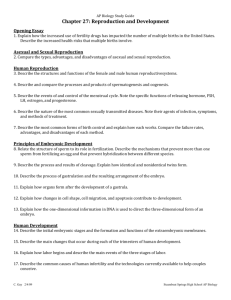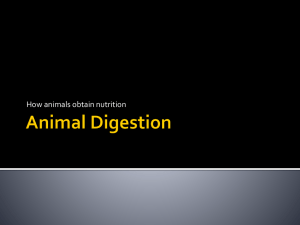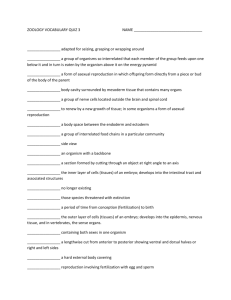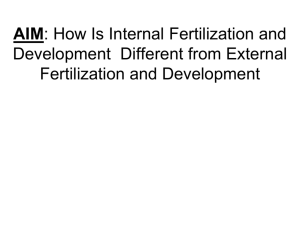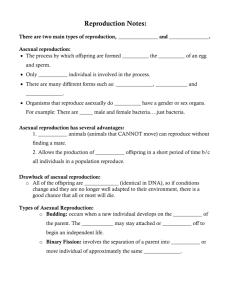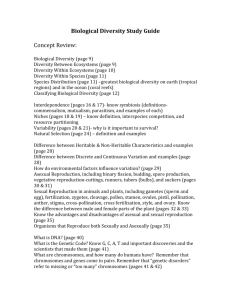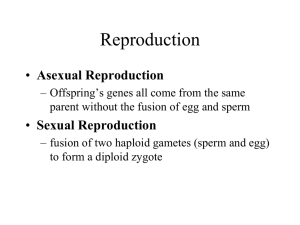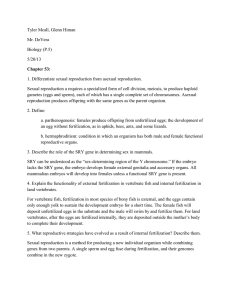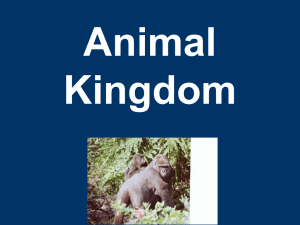Animal Reproduction - Smyth County Schools
advertisement
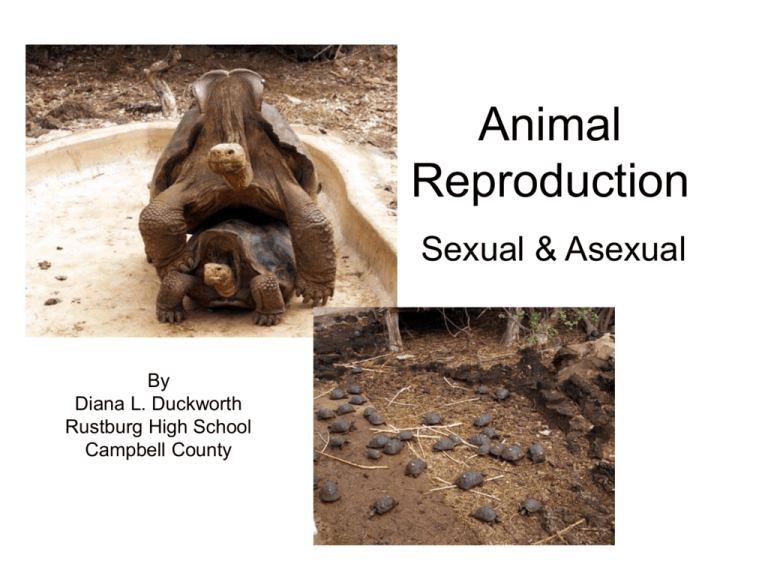
Animal Reproduction Sexual & Asexual By Diana L. Duckworth Rustburg High School Campbell County Asexual Reproduction • Budding – small part of parent’s body grows into new organism http://www.microscope-microscope.org/gallery/MarkSimmons/images/hydra2.jpg Genetically identical clones http://johnson.emcs.net/life/images/anemone.bmp Asexual Reproduction • Regeneration – parent separates into two or more pieces & each piece forms new organism – In some instances just a new part grows – Sponges, sea stars, jellyfish, planaria – Also be clones http://www.starfish.ch/reef/echinoderms.html Asexual Reproduction • Parthenogenesis – growth & development of embryo without fertilization by male • Population all female http://www.nova.edu/ocean/ghri/bbc_virginshark.html Many insects; lizards, salamanders, fish, turkeys Sexual Reproduction – gametes from opposite sexes unite • Species with sexual reproduction are said to be dioecous – separate sexes • Often exhibit distinct sexual dimorphism – males and females look different • Sperm (male gamete) formed by meiosis in testes • Eggs (female gamete) formed by meiosis in the ovary http://civilliberty.about.com/od/historyprofiles/ss/news080406_2.htm Mating • Mating – male & female join together to ensure fertilization; not essential to sexual reproduction http://www.snakesandfrogs.com/scra/lizards/greenanole.htm http://www.torreypine.org/animals/reptiles.html http://www.eeb.cornell.edu/agrawal/photos/milkweed %20fauna/pages/Tetraopes%20tetrophthalmus%20m ating.html http://www.hickerphoto.com/elephants-mating-205-pictures.htm External Fertilization • Males & females release sperm & eggs into the environment – sperm & egg join outside the body – Males & females may come into close proximity – Eggs & larvae develop outside the body – Many gametes produced; many zygotes formed – Usually aquatic http://www.biol.andrews.edu/everglades/organisms/Invertebr ates/marine_inverts/Arthropoda/Atlantic%20Horseshoe%20 Crab/atlantic_horsehoe_index.htm External Fertilization – e.g. Salmon http://escoberphoto.co m/travel/katmai.html http://www.biology-blog.com/blogs/archives/Biology-blog/520525028-Feb-14-2008.html http://www.mass.gov/dfwele/dfw/dfwstksl.htm Internal fertilization • Joining of sperm & egg inside the body after mating – Ensures selection of mate (not random); promotes diversity – Parents protect and care for young – Does not require water; can occur on land – Less sex cells produced; increases probability of successful reproduction – Common in birds, reptiles & mammals Internal fertilization; external development • After fertilization, larvae (embryo) are released & development occurs outside female body • Example: Barnacles http://www.microscopyuk.org.uk/mag/indexmag.html?http://www.microscopyuk.org.uk/mag/artjan99/barnac.html http://getfile.ucoz.com/load/9-1-0-578 Internal fertilization & development • Females put large amounts of energy into development of embryo – very few in litter or clutch – different schemes • Eggs in “shell” are laid and either abandoned or nurtured in nest http://crd.dnr.state.ga.us/content/displaycontent.asp?t xtDocument=542 http://www.fws.gov/archiecarr/photos/index.html http://www.nps.gov/pais/naturescience/reptiles.htm Various levels of parental care http://animals.nationa lgeographic.com/ani mals/photos/babyanimals/americancrocodilebaby_image.html http://www.flmnh.ufl.edu/cnhc/potm-mar99.html Internal fertilization & internal development of eggs; followed by live birth http://earthadvocates.org/index.php?option=com_content&t ask=blogcategory&id=22&Itemid=46 http://www.pacfish.org/sharkcon/documents/gruber.html Internal fertilization, internal development of embryo to fetus, live birth http://www.seahorse-australia.com.au/pages/seahr_biology.html In seahorses, eggs are deposited in the male where they are fertilized and develop. Babies born live. http://www.abc.net.au/science/scribblygum/march2006/ In most species, it is the female who carries the developing fetus to birth… http://humangenetics.suite101.com/article.cfm/three_parent_embryo_mtdna http://www.sciencedaily.com/releases/2008/04/080410184336.htm http://www.scienceclarified.com/El-Ex/Embryo-and-Embryonic-Development.html Hermaphrodites • Organisms that change sex in order to reproduce http://www.dkimages.com/discover/Home/Animals/Inv ertebrates/Molluscs/Gastropods/MarineSnails/Crepidulidae/Atlantic-Slipper/Atlantic-Slipper1.html Crepidula fornicata – a snail http://www.opalesurfcasting.net/la_faune_aquatique/la_crepidule_-_crepidula_fornicata_article1202.html?var_recherche=+bar

